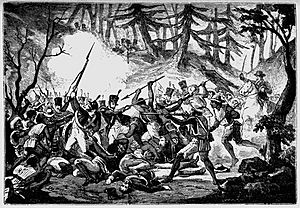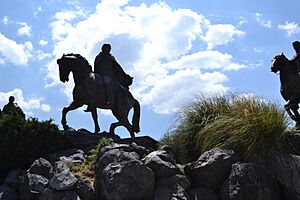Battle of Monte de las Cruces facts for kids
Quick facts for kids Battle of Monte de las Cruces |
|||||||
|---|---|---|---|---|---|---|---|
| Part of the Mexican War of Independence | |||||||
 |
|||||||
|
|||||||
| Belligerents | |||||||
| Commanders and leaders | |||||||
| Miguel Hidalgo y Costilla Ignacio Allende Juan Aldama Mariano Abasolo |
Torcuato Trujillo Agustin Iturbide |
||||||
| Strength | |||||||
| 60,000 - 80,000 irregulars and militias | 1,400 - 7,000 militias | ||||||
| Casualties and losses | |||||||
| 3,000 - 5,000 | 1,000 - 2,500 | ||||||
The Battle of Monte de las Cruces was a very important battle during the early Mexican War of Independence. It happened in October 1810.
This battle was fought between the rebel forces of Miguel Hidalgo y Costilla and Ignacio Allende and the royalist troops of Lt Colonel Torcuato Trujillo. The fight took place in the Sierra de las Cruces mountains, located between Toluca and Mexico City. This battle marked the farthest point the first rebel campaign reached. Even though Hidalgo won the battle, it cost many lives. After this, Hidalgo decided to turn back towards Guadalajara instead of attacking Mexico City. Today, the battlefield is part of La Marquesa National Park, which is also called Miguel Hidalgo National Park.
Contents
How the War Started: The Grito de Dolores
This battle was the end of the first big push in the Mexican War of Independence. The war began with an event called the Grito de Dolores (Cry of Dolores). Father Miguel Hidalgo y Costilla was a priest in Dolores, Guanajuato. He was part of secret groups planning to go against the Spanish colonial government.
One of these secret plans, called the Conspiracy of Querétaro, was found out. Fearing he would be arrested, Hidalgo decided to start the rebellion early. He called on his church members to rise up against the government. This call, the Grito, was an appeal for a better life for Mexicans. It quickly gained support from the poor people in Dolores and the Bajío region. Hidalgo was trusted by the lower classes. Even though he was an upper-class Creole (a person of Spanish descent born in the Americas), he had worked to help poor and indigenous people find more ways to earn money.
This made Hidalgo the leader of the rebel movement. This happened even though Ignacio Allende, another planner, was a trained military commander. The rebel army was mostly a large group of untrained people. They had little or no military order. This army moved through the Bajio region, which is now part of Guanajuato state. They captured cities like San Miguel el Grande, Celaya, and Irapuato easily. More and more people joined the rebels. By the time they left Celaya, Hidalgo had about 80,000 men. The Spanish authorities were surprised by how fast the rebellion grew. Hidalgo's army then went through Querétaro and into what is now the state of Mexico. They headed south and east towards Mexico City, gaining even more volunteers.
Despite their early success, the army had serious problems. Many rebels only had simple weapons like bows and arrows. The biggest worry was that the army lacked discipline and training.
The Battle of Monte de las Cruces
About a month and a half after the Grito de Dolores, Hidalgo's army entered the Toluca Valley. They were on their way to Mexico City. The rebels' actions in Guanajuato scared the wealthy people in New Spain. It also worried many lower-class people in the more traditional valleys of Toluca and Mexico. The city of Toluca asked the Spanish government for help. A group of royalist forces, led by General Torcuato Trujillo, was sent to help.
Trujillo's royalist army took strong positions in the Sierra de las Cruces mountains. These mountains separate Toluca from Mexico City. The area has steep valleys and thick forests. This gave the royalists an advantage against the large rebel army. They could place cannons above the approaching troops. Trujillo could also protect the road to Mexico City with soldiers on both sides.
The command of the rebel forces was given directly to Ignacio Allende. This was done to use his military skills. The battle took place in an area called Los Llanos de Salazar. This is in the modern-day town of Ocoyoacac. More than 90,000 rebel troops fought here. The army was split into three groups. One group of 30,000 men took the Temoaya/Jiquipilco road on the west side. Another group approached from the south through Mexicaltzingo. The main troops, led by Allende and Hidalgo, were in the middle. The plan was to surround Trujillo's forces.
The battle started around 8 AM on October 30, 1810. It was a cold day in a pine forest on rough land. The battle had three main parts. Each part was a new attack by the rebel army against the royalist positions. The first two attacks were pushed back. But the rebels managed to surround the royalists. Before the third attack, Hidalgo sent people to ask the royalists to give up. However, the royalist commander killed these messengers. This made the rebel troops very angry.
The third attack was successful. It cleared the road for the rebels to advance towards Mexico City. However, the rebel army suffered heavy losses. About 2,000 troops died, and many more were hurt. This was because the rebel troops were not well trained and did not have modern weapons.
Why the Rebels Didn't Attack Mexico City
After the battle, Hidalgo's troops moved as far as Cuajimalpa. Today, this area is just inside Mexico City. At the same time, Hidalgo sent a message saying he wanted to talk to the viceroy, Francisco Javier Venegas. But then, Hidalgo decided not to go forward into Mexico City. Instead, he chose to retreat towards Guadalajara. The real reason for this decision is not fully known. However, people have suggested several ideas.
One idea is that Hidalgo heard that another royalist army, led by Calleja, was on its way. This was before he knew if the viceroy had received his request for a meeting. Hidalgo's troops had lost many men at Las Cruces. He worried they could not survive another royalist attack. Another idea is that Hidalgo was a priest, not a soldier. The violence of the battle horrified him. He did not want to see the bloodshed or the riots that happened in other cities repeated in Mexico City.
Another explanation is that about 40,000 of Hidalgo's volunteer troops left the army after the battle. Efforts to get more local people to join failed. There was also disagreement among the rebel leaders about what to do next.
The battle weakened the royalist army, but it did not completely destroy it. The royalists were able to gather their forces again. They chased Hidalgo's army as it retreated.
The Battlefield Today
The place where the battle happened is now part of La Marquesa National Park. Its official name is Miguel Hidalgo National Park. It is in the Los Llanos de Salazar area, within the town of Ocoyoacac, Mexico state. The battlefield has an obelisk monument built in the 1960s. It honors the event and calls Hidalgo the first "caudillo" (leader) of Mexican Independence. A second monument at the battlefield has large bronze statues of Hidalgo, Allende, and José Mariano Jiménez on horseback.
The old road that the rebels fought to clear has been replaced by a modern highway. This highway connects Mexico City and Toluca. You can barely see the remains of the original road from the highway. Los Llanos de Salazar is now full of food stands and places for fun activities. These businesses are even around the monuments, and sometimes graffiti damages them.
Cuajimalpa, where Hidalgo's troops turned around, also has monuments to the rebel army. There is a statue of Hidalgo in the community of San Lorenzo Acopilco. This marks the farthest point the rebel army reached. A local story says that a priest blessed the water of a spring near this spot.
See also
 In Spanish: Batalla del Monte de las Cruces para niños
In Spanish: Batalla del Monte de las Cruces para niños


